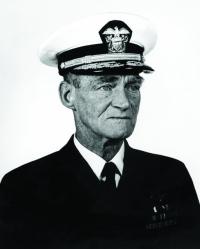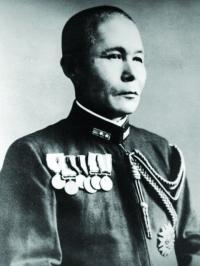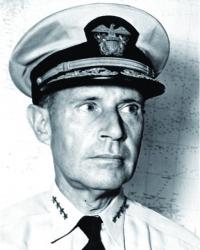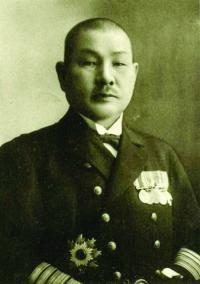Written By: Sam Ghaleb, Ridgecrest, Calif.

Vice Admiral Marc A. Mitscher

Japanese Admiral Jisaburo Ozawa

Admiral Raymond Spruance

Japanese Admiral Soemu Toyoda, C-in-C of Combined Fleet.

President Harry S. Truman(l) and Vice Admiral Marc A. Mitscher(r).
Seventy years ago, the Battle of the Philippine Sea took place on 19-20 June 1944. This battle was the fifth, and the last, great carrier vs. carrier battle between the US Navy and the Imperial Japanese Navy in World War II. The other four battles were all fought in 1942, in the Coral Sea, Midway, the Eastern Solomons and Santa Cruz near Guadalcanal. This great carrier battle was fought by nine Japanese carriers of the Japanese Combined Fleet against the fifteen US carriers in Task Force 58 of the Fifth Fleet. This battle was the largest carrier battle ever fought in history.
The Marianas Islands is a group of 14 islands stretching more than 460 miles in the western Pacific. The islands were under Japanese control in World War II. They were vital to Japan because of their close proximity to The Philippines, Formosa, and Japan itself. Because of their importance as a defensive barrier to Japan, the Marianas Islands were heavily garrisoned by Japanese Army troops, and had air bases on the islands of Saipan, Tinian, and Guam which are part of the Marianas Chain. Any attack by the US to occupy these islands would leave the Philippine Islands, and Japan itself, vulnerable to U.S. attacks, especially if airbases are established on these islands and US bombers could fly to Japan and bomb their industrial centers and cities to ruins. This is precisely what Japan feared most.
The Japanese had planned for an attack on the Marianas by the U.S. The code name for their plan was “Operation A-Go.” Under the command of Vice-Admiral Jisaburō Ozawa, the Imperial Japanese Navy assembled a powerful fleet, which included nine carriers with 450 planes, five battleships, 13 cruisers, and 28 destroyers. Japanese pilots flying from their carriers were full of determination, as usual, but they had only a fourth as much training and experience as the U.S. Navy pilots. This left the Japanese aircraft vulnerable to U.S. Navy fighters. Most of the experienced Japanese pilots and air crews were lost in the previous carrier battles in 1942. Admiral Ozawa also counted heavily on the 500 or so ground-based planes that had been flown ahead to Guam and other islands in the area. He hoped that a few "lucky" hits on the US carriers would do the job.
The U.S. force that was sent to invade the Marianas on 15 June was protected by the 5th fleet commanded by Admiral Raymond Spruance. The tactical commander of the carrier task force was Admiral Marc Mitscher. His carriers were grouped into Task Force 58. The over all strength of Task Force 58 was 15 carriers, seven battleships, 21 cruisers, and 69 destroyers. The carriers had, between them, more than 900 aircraft of all types. This was a truly powerful strike force
On 19 June 1944, the Japanese were first to strike. Their scouting seaplanes gave Admiral Ozawa the information he needed. Orders were given to launch a full strike. It included 45 fighter-bombers, eight torpedo bombers and 16 Zero fighters. These were followed by a force of 128 planes, and then another 47 planes. In just an hour, the Japanese sent out 244 planes.
The Japanese first strike was immediately picked up on U.S. radars 150 miles away. Admiral Mitscher responded by launching the famous and highly capable Grumman F6F Hellcat fighters. The Japanese pilots had no chance against the experienced US Navy pilots. The Japanese force was repelled with heavy losses. However they managed to land just one bomb on the battleship USS South Dakota while losing 41 aircraft. By the end of the day the Japanese lost 315 planes.
On 20 June, US scout planes finally located the Japanese fleet. Admiral Mitscher gave the order to launch 230 torpedo planes and dive bombers to attack immediately. He then discovered that the enemy was actually another 60 miles further out. Unless he recalled his planes, it was unlikely that his pilots would make it back. He did not recall the planes. The attack was successful, sinking the light carrier Hiyo and two oilers, and damaging three other carriers and a battleship. Escorting Hellcat fighters also shot down more Japanese planes. The Japanese lost a further 65 planes and by the end of the attack, 20 US Navy planes were shot down.
As the planes were flying back to the carriers, night was approaching and they were running out of fuel. Admiral Mitscher decided to fully illuminate the carriers, despite the risk of attack from submarines. All ships of the task force turned on their lights, and the screening destroyers fired starshells throughout the recovery, which lasted for two hours. Despite these measures, more than 100 of the returning aircraft, with pilots neither trained nor equipped for night landing, were lost. Some of these planes crashed on flight decks, and the majority ditched into the sea. One hundred and sixty of their crews were rescued in the following few days.
By the end of the second day, Admiral Ozawa had only 35 planes left. He realized that he had no hope of continuing the fight and signaled Admiral Soemu Toyoda, C-in-C of Combined Fleet, that he was retreating toward Okinawa. During two days of intensive strikes, Admiral Ozawa had lost 375 planes in total.
In the end, Task Force 58 lost 120 aircraft, while the Japanese fleet suffered heavy losses. Three of Admiral Ozawa’s carriers were sunk, two of them by submarines, including the Shokaku, a veteran of the attack on Pearl Harbor. Japanese naval air power basically ceased to exist after the battle. Almost 600 Japanese aircraft were destroyed in the air, or on the ground on the island of Guam. The strike from Guam, which Admiral Ozawa hoped would aid his effort, never materialized.
Never in the history of modern naval warfare was there such a lopsided victory. The Battle of the Philippine Sea was a decisive US Naval Victory. As one pilot from the aircraft carrier USS Lexington remarked, it was, "...just like an old time turkey shoot,” and the name stuck.
NEXT WEEK:
OPERATION BAGRATION
«Go back to the previous page.




